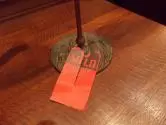Seller Beware!

It seems in recent weeks that I have received an increased number of emails from readers who are wanting to sell an antique or work of art. In addition to wanting my recommendation for how to go about selling it, they invariably also want to know something else: how much is it worth?
In some cases, similar examples may have sold at auction, so if you were selling a model #332 Craftsman Morris chair, you could search Arts and Crafts auction websites and determine a price range. Even if you found the identical piece in the same condition as yours, however, the price it sold for is still just a starting point, as I will explain shortly.
If your research indicates it could be rare and valuable, then you should hire the services of a professional appraiser with extensive experience in your type of antique. Just make sure the appraiser is not also interested in buying your piece, as that constitutes an obvious conflict of interest.
If you are planning to sell your piece through an auction house, then their staff should be able to help you determine a range in which they would expect it to sell, generally called the pre-sale estimate. Note the word “estimate.” This is not a guarantee. It can go higher, and it most certainly can go lower.

Some people love to sell at auction, for the lure of a potential blockbuster bidding war, like winning the lottery or drawing an ace-king combo at the blackjack table, is hard to resist. But before you decide to go that route, ask critical questions, such as how much commission do they charge you, is there a fee for photography, is there a fee for insurance, how is the reserve set, who pays transportation costs, is there a fee if it does not sell, when is the next appropriate auction for it, and how long after the auction do you have to wait to get paid?
Another option is to sell to a dealer. This typically goes faster, but with two caveats: the seller has to name the asking price, and the seller has to recognize that a dealer cannot pay full retail value and expect to show the profit necessary to stay in business. But many of the fees that an auction house will charge are avoided in a dealer transaction, so you just have to do your research — and then do the math.
Finally, you can sell to a collector. This can take start online or by placing a traditional print ad. Again, the seller must first state an asking price, but a collector who is not concerned about reselling it for a profit may accept it or counter with an acceptable offer. Pitfalls include the most obvious: all the risks of dealing with a stranger. These can range from a bad check to having a pair of suspicious characters show up at your house with the intent of walking away with more than just the piece you have for sale.
With either of these latter two options, there are certain safeguards you should institute, such as letting the buyer know you accept only cash, that you will meet in a public place to make the exchange, and that you will have someone there with you.
A final few words on pricing. If you set an unrealistic value on your piece, then be prepared for it not to sell — or for you to get far less at auction or from a dealer or collector.
As one astute collector said, “The true value of a piece is the price at which both the buyer and the seller are pleased.”

Until next Monday,
The more you know, the more you get.
Bruce
